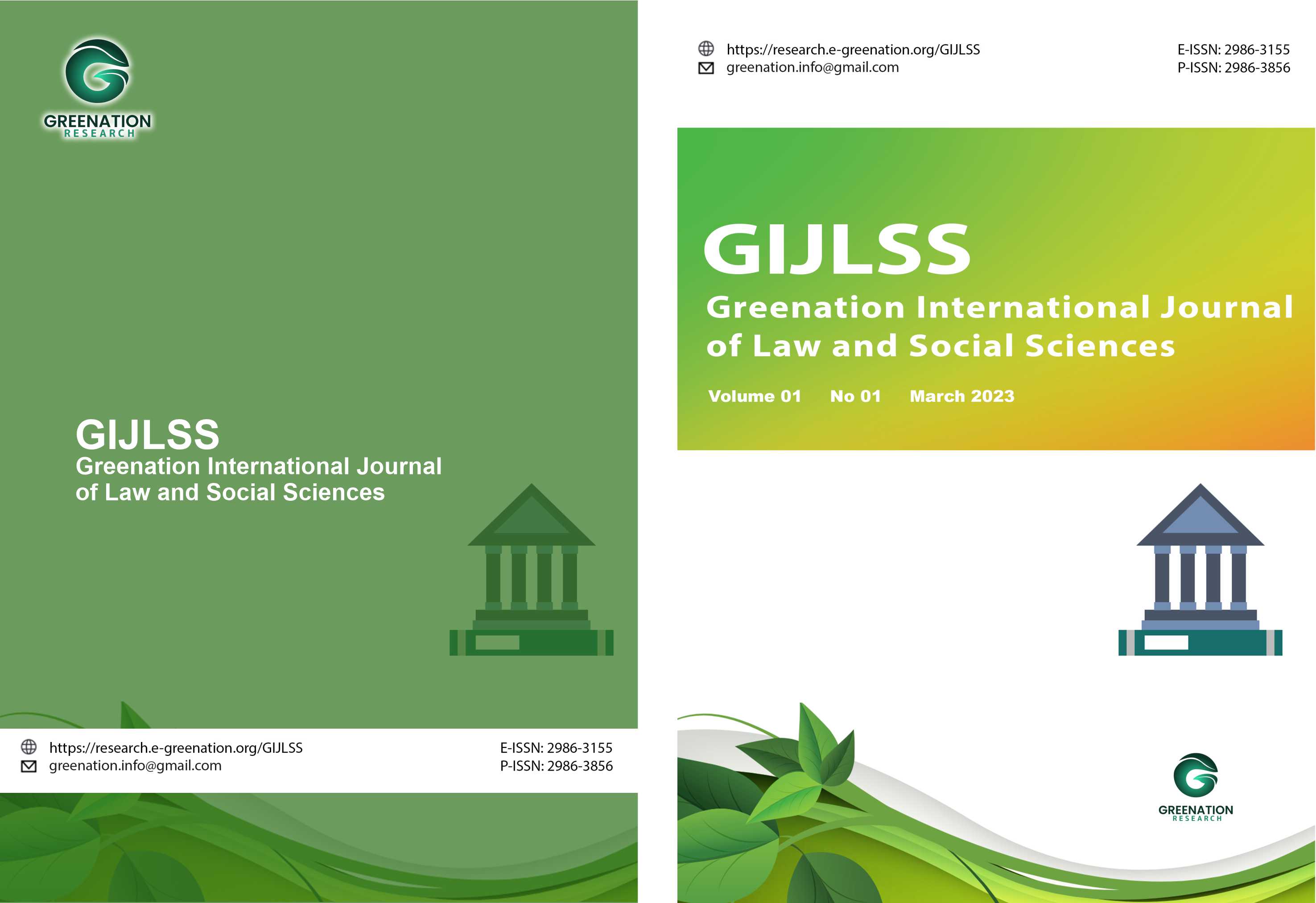Optimizing Asset Recovery Through the Implementation of Article 12 B (Gratification) and Money Laundering in Handling Corruption Crimes
DOI:
https://doi.org/10.38035/gijlss.v3i3.592Keywords:
Asset Recovery, Gratification, Money LaunderingAbstract
One of the goals of the Corruption Eradication Law is asset recovery. This is evident in the Law Number 20 of 2001 modification to Law Number 31 of 1999 for the Eradication of Corruption. This is inextricably linked to lawmakers' understanding that corruption is a serious crime that harms the country's economy by causing state assets to be unlawfully transferred to corrupt officials and their associates. This research aims to analyze how law enforcement officials, specifically the Corruption Eradication Commission (KPK), can implement existing articles and laws to maximize the recovery of state financial losses due to corruption before the asset confiscation law is enacted by the government. This research uses an empirical legal research method, examining how the law works to achieve its objectives. The theory used is Nonet and Selznic's responsive legal theory. This theory teaches that law is not merely a system of regulations but examines the impact of the application of legal norms on the objectives of the law itself. According to the study's findings, law enforcement officials at the Corruption Eradication Commission (KPK) can use information from the State Officials' Wealth Report (LHKPN) to spot increases in the wealth of suspected corruption offenders in order to achieve one of the goals of the corruption law, which is the recovery of state financial losses or asset recovery, prior to the implementation of the asset confiscation law. This data is combined with secondary data from field surveys on the wealth ownership of suspected corruption perpetrators and data from other stakeholders such as the Financial Transaction Reports (PPATK), Banking, Taxation, National Land Agency (BPN), and others. This spike in wealth is then analyzed in relation to the period of the spike and correlated with the position of the suspected corruption perpetrator at the same time. Furthermore, Article 3 of Law Number 8 of 2010 concerning the Crime of Money Laundering, as well as Article 12B (Gratification) of Law Number 31 of 1999, as amended and supplemented by Law Number 20 of 2001, apply.
References
Ali, A., & Heryani, W. (2013). Menjelajahi kajian empiris terhadap hukum. Jakarta: Kencana.
Bakhri, S. (2009). Hukum pembuktian dalam praktik peradilan pidana. Jakarta: Pusat Kajian dan Pengembangan Ilmu Hukum (P3IH) Fakultas Hukum Universitas Muhammadiyah.
Chazawi, A. (2013). Hukum pembuktian tindak pidana korupsi. Malang: Bayu Media.
Chazawi, A. (2017). Hukum pidana korupsi di Indonesia (Edisi revisi). Jakarta: Rajawali Press.
Dhermawan, A. O. (2009). Memahami filsafat hukum dari teori-teori. Jakarta: Ubhara Jaya Press.
Fuady, M. (2013). Teori-teori dalam sosiologi hukum (Cetakan kedua). Jakarta: Kencana.
Fuady, M. (2005). Perbuatan melawan hukum: Pendekatan kontemporer. Bandung: Citra Aditya Bakti.
Komisi Pemberantasan Korupsi. (2020). Panduan memahami tipologi pencucian uang dari korupsi dan strategi penanganannya. Jakarta: Komisi Pemberantasan Korupsi.
Lev, D. S. (1990). Hukum dan politik di Indonesia. Jakarta: Pustaka LP3ES.
Mangesti, Y. A., & Tanya, B. L. (2014). Moralitas hukum. Yogyakarta: Genta Publishing.
Marpaung, L. (2007). Tindak pidana korupsi: Pemberantasan dan pencegahan. Jakarta: Djambatan.
Nuraeny, H. (2012). Wajah hukum pidana: Asas dan perkembangan. Bekasi: Gramata Publishing.
Subianto, P. (2017). Paradoks Indonesia. Jakarta: Koperasi Garudayaksa Nusantara.
Tuanakotta, T. M. (2009). Menghitung kerugian keuangan negara dalam tindak pidana korupsi. Jakarta: Salemba Empat.
Wiyono, R. (2005). Pembahasan undang-undang pemberantasan tindak pidana korupsi. Jakarta: Sinar Grafika.
Yuanara, E. (2012). Korupsi dan pertanggungjawaban pidana korporasi: Berikut studi kasus. Bandung: Citra Aditya Bakti.
Law of the Republic of Indonesia Number 28 of 1999 concerning State Administration that is Clean and Free from Corruption, Collusion, and Nepotism. State Gazette of the Republic of Indonesia Number 75 of 1999, Supplement to the State Gazette of the Republic of Indonesia Number 3851.
Law of the Republic of Indonesia Number 7 of 2006 concerning Ratification of the United Nations Convention Against Corruption, 2003 (United Nations Convention Against Corruption, 2003). State Gazette of the Republic of Indonesia Number 32 of 2006, Supplement to the State Gazette of the Republic of Indonesia Number 4620.
Law of the Republic of Indonesia Number 19 of 2019 concerning the Second Amendment to Law Number 30 of 2002 concerning the Corruption Eradication Commission. State Gazette of the Republic of Indonesia 2019 Number 197, Supplement to the State Gazette of the Republic of Indonesia Number 6409.
United Nations Convention against Corruption (UNCAC), 2004 (Article 20).
Putusan Pengadilan Tinggi DKI Nomor 8/Pid.Sus-TPK/2024/PT DKI (Tanggal 2 Februari 2024).
Belia, Brigita. (2023, October 25). Yasonna bicara kesulitan berantas 4 jenis korupsi gegara belum diatur UU. DetikNews. https://news.detik.com/berita/d-7001213/yasonna-bicara-kesulitan-berantas-4-jenis-korupsi-gegara-belum-diatur-uu
Wahyuni Diahsari, Mirza Bagaskara, & M. Rosseno Aji. (2023, March 31). Kronologi lengkap kasus Rafael Alun: Dari kasus penganiayaan hingga jadi tersangka KPK. Tempo.co. https://www.tempo.co/hukum/kronologi-lengkap-kasus-rafael-alun-dari-kasus-penganiayaan-hingga-jadi-tersangka-kpk-202934
Downloads
Published
How to Cite
Issue
Section
License
Copyright (c) 2025 Asep Guntur R, Azis Budianto

This work is licensed under a Creative Commons Attribution 4.0 International License.
Copyright :
Authors who publish their manuscripts in this journal agree to the following conditions:
- Copyright in each article belongs to the author.
- The author acknowledges that the Greenation International Journal of Law and Social Sciences (GIJLSS) has the right to be the first to publish under a Creative Commons Attribution 4.0 International license (Attribution 4.0 International CC BY 4.0).
- Authors can submit articles separately, arrange the non-exclusive distribution of manuscripts that have been published in this journal to other versions (for example, sent to the author's institutional repository, publication in a book, etc.), by acknowledging that the manuscript has been published for the first time at GIJLSS.
























